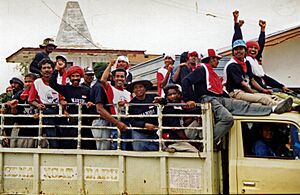Mahidi
Quick facts for kids Mahidi |
|
|---|---|

Mahidi t-shirt lettering
|
|
| Leader(s) | Câncio Lopes de Carvalho |
| Foundation | December 1998 |
| Dates of operation | 1999–2000 |
| Country | East Timor |
| Motives | Prevention of East Timor's independence |
| Headquarters | Ainaro, East Timor |
| Active regions | East Timor |
| Political position | Right-wing |
| Major actions |
|
| Notable attacks | Timor-Leste Scorched Earth campaign |
| Status | Defunct |
The Mahidi (which means "Live and Die with Indonesia" in Indonesian) was a group of armed people, also known as a militia, in East Timor. They were loyal to Indonesia. This group started from people who had lost land and power. Some of them had fought against the Portuguese, and others had worked with the Japanese during World War II.
The Mahidi group was formed in December 1998. Their main activities were in the Cassa area, located in the southern part of the Ainaro district. This spot was important because it was where the Manufahi, Ainaro, and Cova Lima districts met. Mahidi was involved in the 1999 East Timorese crisis. They were one of the groups that took part in many conflicts during that time. They were connected to a tragic event at the Suai Church, where many lives were lost, and other serious incidents.
Contents
Mahidi's Beginnings
The leader of the Mahidi group was Câncio Lopes de Carvalho. In December 1998, he restarted a youth movement that supported East Timor staying with Indonesia. He had led this movement in the early 1990s. He renamed it Mahidi. This was done on behalf of a special Indonesian military unit called Kopassus.
On January 1, 1999, the Mahidi group had a special ceremony in Ainaro. Leaders of the Indonesian police and military were there. Some people said that members were forced to join the group. Câncio's brother, Nemecio, was an intelligence officer for Mahidi. The group was formed because more and more people in Ainaro district wanted independence. Some houses in the area had been burned down.
Group Size and Weapons
By April 1999, Mahidi had between 1,000 and 2,000 members. They also had about 500 firearms. Câncio Lopes de Carvalho told the BBC that he had received an automatic weapon from the military in Ainaro.
Mahidi's main base was in Cassa, Ainaro, in the southern part of the area. They also had smaller groups in every village in Ainaro. Another important center was set up in Manutaci under Daniel Pereira. Some of the group, led by Vasco da Cruz, even moved into the nearby area of Cova Lima.
Mahidi's Actions and Aftermath
During 1999, the Mahidi members were involved in many serious actions during an event called Operation Guntur. Human rights groups accused them of many wrongdoings. These conflicts finally stopped when an international peacekeeping force, called INTERFET, arrived.
After the conflicts, Câncio Lopes de Carvalho went to West Timor in Indonesia. He lived in camps there. He asked the Indonesian government for help, saying he had served Indonesia loyally.
In January 2000, Câncio Lopes de Carvalho made a threat. He said he would burn down Kupang, a city in Indonesia, if Indonesia forced East Timorese refugees to return to East Timor. In October 2000, he claimed he had sent some of his men back to East Timor for secret operations. At the same time, he offered to give information to the United Nations Secretary General about the Kopassus's involvement in the 1999 conflicts. In return, he asked for forgiveness if he returned to East Timor. The UNTAET group refused his offer.
By October 2001, some Mahidi members had already returned to East Timor. This included 378 refugees led by Nemecio Lopes de Carvalho, who was a deputy leader of Mahidi.
Legal Actions Against Mahidi Members
On February 28, 2003, 22 Mahidi members faced charges related to serious actions against people. These charges included causing harm, torture, forcing people to leave their homes, and kidnapping. Among those charged were Vasco da Cruz, Câncio Lopes de Carvalho, his brother Nemecio, and Orlando Baptista.
The charges highlighted several specific events. These included the harm of eleven civilians and forcing people out of Mau-Nuno village on September 23, 1999. Also mentioned were the harm of two young people in Manutaci on January 3, and four pro-independence activists in Galitas on January 25. Additionally, the charges covered the harm and persecution of several students in the Cova Lima district on April 13.
However, at that time, all the accused were in Indonesia, not East Timor. Arrest warrants were issued by the Dili District Court. These warrants were sent to Indonesia's Attorney General's Office and Interpol. After this, some Mahidi members were sentenced to prison.
Images for kids



